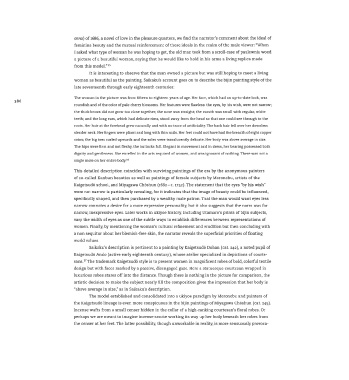Page 387 - Edo: Art in Japan, 1615–1868
P. 387
onna) of 1686, a novel of love in the pleasure quarters, we find the narrator's comment about the ideal of
feminine beauty and the mutual reinforcement of these ideals in the realm of the male viewer: "When
I asked what type of woman he was hoping to get, the old man took from a scroll-case of paulownia wood
a picture of a beautiful woman, saying that he would like to hold in his arms a living replica made
from this model." 15
It is interesting to observe that the man owned a picture but was still hoping to meet a living
woman as beautiful as the painting. Saikaku's account goes on to describe the bijin painting style of the
late seventeenth through early eighteenth centuries:
The woman in the picture was from fifteen to eighteen years of age. Her face, which had an up-to-date look, was
386
roundish and of the color of pale cherry blossoms. Her features were flawless: the eyes, by his wish, were not narrow;
the thick brows did not grow too close together; the nose was straight; the mouth was small with regular, white
teeth; and the long ears, which had delicate rims, stood away from the head so that one could see through to the
roots. Her hair at the forehead grew naturally and with no trace of artificiality The back hair fell over her downless
slender neck. Her fingers were pliant and long with thin nails. Her feet could not have had the breadth of eight copper
coins; the big toes curled upwards and the soles were translucently delicate. Her body was above average in size.
The hips were firm and not fleshy, the buttocks full. Elegant in movement and in dress, her bearing possessed both
dignity and gentleness. She excelled in the arts required of women, and was ignorant of nothing. There was not a
single mole on her entire body. 16
This detailed description coincides with surviving paintings of the era by the anonymous painters
of so-called Kanbun beauties as well as paintings of female subjects by Moronobu, artists of the
Kaigetsudó school, and Miyagawa Choshun (1682 - c. 1752). The statement that the eyes "by his wish"
were not narrow is particularly revealing, for it indicates that the image of beauty could be influenced,
specifically shaped, and then purchased by a wealthy male patron. That the man would want eyes less
narrow connotes a desire for a more expressive personality, but it also suggests that the norm was for
narrow, inexpressive eyes. Later works in ukiyoe history, including Utamaro's prints of bijin subjects,
vary the width of eyes as one of the subtle ways to establish differences between representations of
women. Finally, by mentioning the woman's cultural refinement and erudition but then concluding with
a non sequitur about her blemish-free skin, the narrator reveals the superficial priorities of floating
world values.
Saikaku's description is pertinent to a painting by Kaigetsudó Dohan (cat. 242), a noted pupil of
Kaigetsudó Ando (active early eighteenth century), whose atelier specialized in depictions of courte-
17
sans. The trademark Kaigetsudó style is to present women in magnificent robes of bold, colorful textile
design but with faces marked by a passive, disengaged gaze. Here a statuesque courtesan wrapped in
luxurious robes stares off into the distance. Though there is nothing in the picture for comparison, the
artistic decision to make the subject nearly fill the composition gives the impression that her body is
"above average in size," as in Saikaku's description.
The model established and consolidated into a ukiyoe paradigm by Moronobu and painters of
the Kaigetsudó lineage is even more conspicuous in the bijin paintings of Miyagawa Choshun (cat. 245).
Incense wafts from a small censer hidden in the collar of a high-ranking courtesan's floral robes. Or
perhaps we are meant to imagine incense smoke working its way up her body beneath her robes from
the censer at her feet. The latter possibility, though unworkable in reality, is more sensuously provoca-

